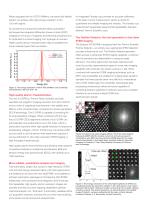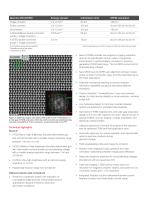 Website:
THERMO FISHER SCIENTIFIC - MATERIALS SCIENCE
Website:
THERMO FISHER SCIENTIFIC - MATERIALS SCIENCE
Group: Thermo Fisher Scientific
Catalog excerpts

Spectra 300 (S)TEM for materials science The ultra-high-resolution, “all-in-one” solution for atomic scale materials characterization The Spectra 300 (S)TEM is the highest resolution imaging and spectroscopic platform from Thermo Fisher Scientific. Wth its wide-gap pole piece and an accelerating voltage range of 30–300 kV, it serves an expansive range of materials investigations. High-resolution structural and chemical information at the atomic level The Thermo Scientific™ Spectra™ 300 (Scanning) Transmission Electron Microscope combines: • A redesigned, high-stability base • A new ultra-high resolution (X-FEG UltiMono) source or an ultra-high brightness (X-CFEG) source • Image and 5th order probe aberration correction (S-CORR) • Single electron sensitive STEM detection • Sensitive energy dispersive X-ray (EDX) detectors By synchronizing these technologies through our advanced software and automation modules, the Spectra 300 (S)TEM makes accessing high-resolution atomic-scale information more efficient, easy and repeatable than ever. Key Benefits High-quality atomic characterization. Optimized electron optical performance and ultra-sensitive detection enables high-quality atomic imaging and analysis in 2D and 3D. Highly repeatable data. Sophisticated software automation routines such as OptiSTEM+ and OptiMono+ optimize the system to its peak performance, resulting in more repeatable and quantifiable data. Optimized EDS performance. Guaranteed by a portfolio of symmetric detector geometries, which contributes to our unique quantification capability, in combination with an ultra-high brightness X-CFEG to provide rapid EDS mapping across a wide range of materials. In situ and dynamic research. Fast cameras, chemical detectors, smart software and our wide gap S-TWIN lens enable in situ data acquisition with no compromise on resolution and analytical capabilities. High environmental stability. The redesigned enclosure and ultra-stable Spectra 300 (S)TEM base with passive and (optional) active vibration isolation (with iVIS) minimize external environmental influences and ensure high-quality data from long-term and short-term experiments. A wide range of materials science research in one platform. Our unique combination of optics, ultra-sensitive detection and wide-gap pole piece ensures that even light, highly sensitive materials can be characterized at the atomic scale. Investigate a wide range of materials at the atomic scale By combining a large-gap objective lens (the Thermo Scientific S-TWIN Lens) with superior optics and analytics, the Spectra 300 (S)TEM delivers both performance and flexibility in one tool. The six-fold astigmatism (A5) probe corrector (S-CORR) of the Spectra 300 (S)TEM delivers our highest available STEM resolution specification at 300 kV (50 pm) and 60 kV (96 pm) and provides in situ, dynamic and 3D EDS tomography capability without the need for non-standard holders or sample types. Figure 1. HAADF (DCFI) STEM image of GaN [212] at 300 kV showing 40.5 pm Ga-Ga dumbbell splitting and 39 pm resolution in the FFT on a wide gap (S-
Open the catalog to page 1
When equipped with an X-FEG UltiMono, the same fully flexible An integrated Faraday cup provides an accurate calibration system can achieve ultra-high energy resolution in the of the beam current measurement, which is pivotal for quantitative and reliable imaging and analysis. The Faraday cup measurement guarantees experimental repeatability between Our powerful and advanced software allows specialized techniques like integrated differential phase contrast (iDPC) imaging for the study of magnetic and electrical properties and for optimized Z-contrast imaging from hydrogen to uranium. Higher...
Open the catalog to page 2
Energy spread Information limit STEM resolution X-FEG/UltiMono double corrected 0.025 eV*** 60 pm 50 pm (125 pm at 30 kV) (probe + image corrector) X-CFEG double-corrected 0.4 eV 70 pm 50 pm (136 pm at 30 kV) (probe + image correction) * For X-FEG/Mono unless otherwise specified. Note: All specifications are at 300 kV using an S-TWIN lens (unless otherwise noted). ** Depending on energy filter options. *** Specification for 60 kV. Figure 5. GaN[110] imaged with iDPC STEM at 60 kV with X-FEG/Mono on a wide gap S-TWIN pole piece. Both Ga and N columns are simultaneously revealed using iDPC at...
Open the catalog to page 3
Stage • Computerized 5-axis, ultra-stable specimen piezo stage for accurate recall of stored positions and tracking of the areas visited during sample navigation. The piezo stage allows for movements as fine as 20 pm for centering of feature of interest in the field of view • Tilt range ±40 degrees for analytical double tilt holder* to access the maximum number of zone axes of each crystal in a polycrystalline material. With tomography holder, ±75 degrees to minimize the missing wedge in 3D reconstructions • Linear drift compensation provided by piezo stage can be used to mitigate...
Open the catalog to page 4
Software • The Electron Dose Control (EDC) module predicts beam current, dose, and dose-rate live based on gun and optics settings. The EDC calibration is done with a built-in Faraday cup. Users can set electron dose without knowledge of TEM optics. The beam current, dose, and dose-rate are reported in Velox Software along with image metadata. • Differential phase contrast (DPC) STEM technique enables live measurements of intrinsic magnetic and electric fields • Integrated DPC (iDPC) software for high imaging contrast in STEM on materials across the whole periodic table. This low-dose...
Open the catalog to page 5All THERMO FISHER SCIENTIFIC - MATERIALS SCIENCE catalogs and technical brochures
-
Phenom XL G2 Desktop SEM
6 Pages
-
ChemiSEM Technology
3 Pages
-
Helios 5 Laser Hydra System
4 Pages
-
Phenom Pharos G2
4 Pages
-
Helios 5 CX DualBeam
4 Pages
-
Phenom Pure G6 Desktop SEM
4 Pages
-
Phenom ParticleX TC
6 Pages
-
Phenom ParticleX Steel
6 Pages
-
V400ACE Focused Ion Beam
2 Pages
-
Scios for Materials Science
4 Pages
-
Talos
2 Pages
-
Titan? ETEM G2
4 Pages
















